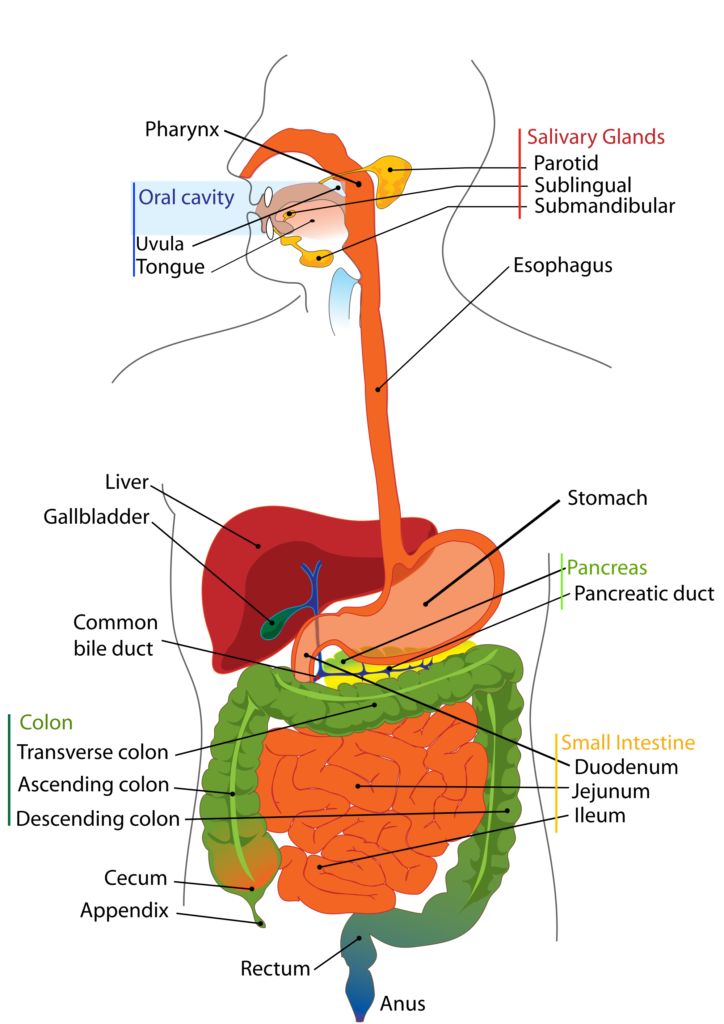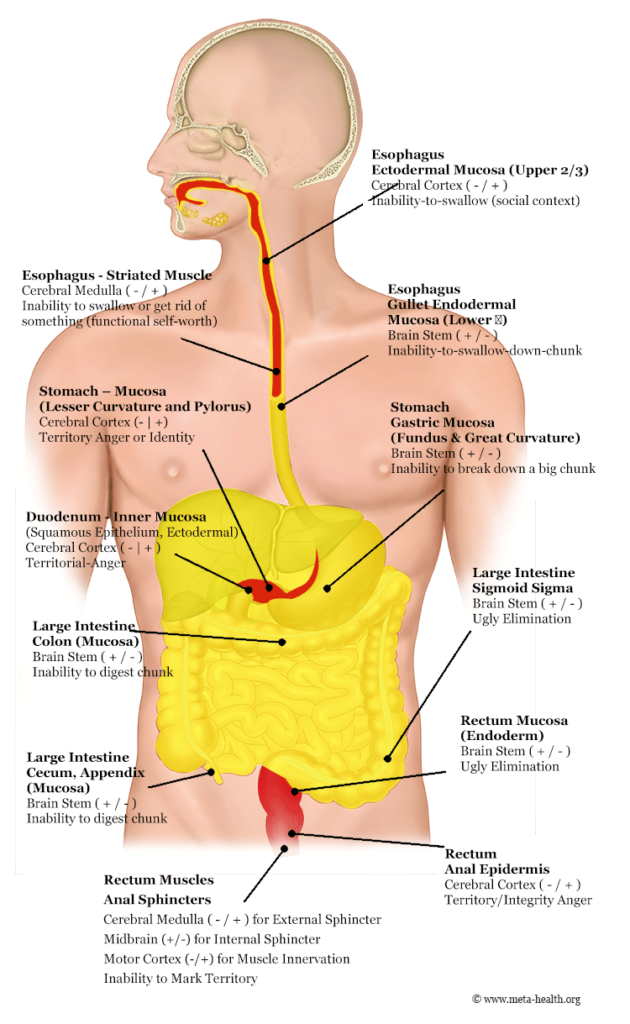Digestion is a form of catabolism: a breakdown of large chunks to smaller ones in order to release and absorb the needed substances and informations.

To prepare this, the mere thinking of a desired food, as well as visual or olfactory impressions, stimulates salivation. Saliva is a liquid secreted by the parotis, the sublingual and submandibular glands, as well as in the salivary glands of the submucosa of the mouth. It contains salivary amylase, an enzyme which starts the digestion of starch in the food. Saliva also promotes the travelling of the morsel. When food enters the mouth, digestion of the food starts by the action of mastication, a form of mechanical digestion, and the wetting contact of saliva. After undergoing mastication and starch digestion, the food will be in the form of a small, round slurry mass called a bolus.
Helped by the tongue, it will then travel through the pharynx, down the esophagus and into the stomach by the action of peristalsis. Gastric juice in the stomach starts protein digestion. Gastric juice mainly contains hydrochloric acid and pepsin. As these two chemicals may damage the stomach wall, mucus is secreted by the stomach, providing a slimy layer that acts as a shield against the damaging effects of the chemicals. To protect the esophagus from the gastric juice, they are divided by the cardiac sphincter (LES) at the entrance of the stomach.
At the same time protein digestion is occurring, mechanical mixing occurs by peristalses which are waves of muscular contractions that move along the stomach wall. This allows the mass of food to further mix with the digestive enzymes. After some time (typically 1-2 hours in humans) the resulting thick liquid is called chyme. When the pyloric sphincter valve opens, chyme enters the duodenum where it mixes with digestive enzymes from the pancreas, and then passes through the small intestine, in which fat digestion continues with help of secretes from liver and gall bladder. When the chyme is fully digested, it is absorbed into the blood.
95% of absorption of nutrients occurs in the small intestine with the help of microbes. The intestinal microflora consists of 500-1,000 different kinds of bacteria, serving several functions such as digestion, immune modulation, production of vitamins, stimulation of peristalsis, nourishment of intestinal tissue and detoxification of xenobiotics.
Water and minerals are re-absorbed back into the blood in the colon (large intestine) where the pH is slightly acidic (about 5.6 ~ 6.9).
Some vitamins, such as biotin and vitamin K (K2MK7) produced by bacteria in the colon are also absorbed into the blood in the colon. Waste material is eliminated from the rectum during defecation.

META-Organ Tissues
From a META-Point of View we distinguish organs and organ tissues based on their unique stress-emotion-belief associations and brain relay locations.
- Mouth, Tongue – Endodermal Mucosa (BS +/-): Analysis, assimilation, spitting out
- Mouth, Tongue – Ectodermal Mucosa (CC -/+): Gustation, expression
- Salivary Glands (BS +/-): Need to assimilate, spit out
- Salivary Gland Ducts (CC -/+): Allowance to assimilate or to reject
- Submucosa / Connective Tissue layer (CM -/+): Ability to manage
- Tonsils (BS +/-, CM -/+): Assimilation, choice
- Upper Mucosa (CC -/+): Allowance to assimilate or to reject
- Lower Mucosa & LES (BS +/-): Need to assimilate
- Muscle (MB +/-, CB -/+): ability to incorporate or reject
- Submucosa / Connective Tissue layer (CM -/+): Ability to manage
- Fundus and Great Curvature (BS +/-): Need to digest / process / chunk down
- Lesser Curvature and Pylorus (CC -/+): Identity, terriorial/social anger
- Muscle (MB +/-): Need to process / hold / forward
- Submucosa / Connective Tissue layer (CM -/+): Ability to manage
- Liver – Parenchyma (BS +/-): Existence, Starvation, Resources
- Gallbladder and Bile Ducts (CC -/+): Identity, terriorial/social anger
- Muscle layer (MB +/-): Need to manage anger
- Submucosa / Connective Tissue layer (CM -/+): Ability to manage
- Pancreas Gland (BS +/-): Need to digest / process / chunk down
- Pancreas Ducts (CC -/+): Identity, terriorial/social anger
- Bulbus Mucosa: (CC -/+): Identity, terriorial/social anger
- Villi (BS +/-): Digestion, Resentment
- Muscle layer (MB +/-): Need to manage anger
- Submucosa / Connective Tissue layer (CM -/+): Ability to manage
Jejunum, Ileum (BS +/-): Digestion, Absorption, Resources
Cecum and Appendix (BS +/-): Digestion, Self-Protection, Resources
- Colon Mucosa (BS +/-): Elimination, Resources
- Smooth Muscle (MB +/-): Retain, Pass on
- Intestinal Lymphatic Tissue (CM -/+): Integrity, Detoxification
- Sigmoid Colon (BS +/-): Elimination
- Rectum – Endodermal Mucosa (BS +/-): Elimination
- Rectum – Anal Mucosa (CC -/+): Identity, Terriorial/Social Anger
- Anal Sphincter Muscles (MB +/-, CM -/+): Need to retain, Territory-Marking
Peritoneum (CB +/-): Protection of the abdomen
- Greater Omentum (CB +/-): Protection of the abdomen, resources
The text links lead into the META-Wiki in IMMA’s members portal
Study how biological programming impacts mental and physical health, and become a pathfinder to well-being!
pictures: IMMA, wikipedia (user Mariana Ruiz Villarreal)
